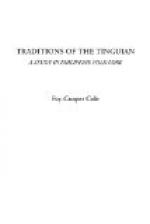Previous writers—among them Ratzel and Graebner [77]—have sought to account for certain resemblances in culture, between Malaysia, Polynesia, and America, by historical connection. A part of our material—such as that of the blood-clot child (p. 125), [78] the rape of the maiden by the vine which carries her to the sky (p. 33), the magic flight (p. 75), and magic growth (p. 38) [79]—may seem to lend support to such a theory. These similarities are assuredly suggestive and interesting, but it appears to the writer that the material is too scanty and the folklore of intervening lands too little known to justify us in considering them as convincing proof of borrowing over such immense distances. [80]
General Results
Our study has brought out certain general results. We have seen that Tinguian folklore has much in common with that of other tribes and lands. While a part of this similarity is doubtless due to borrowing—a process which can still be seen at work—a considerable portion of the tales is probably of local and fairly recent origin, while the balance appears to be very old. These older tales are so intimately interwoven with the ceremonies, beliefs, and culture of this people that they may safely be considered as having been developed by them. They are doubtless much influenced by present day conditions, for each story teller must, even unconsciously, read into them some of his own experiences and the current beliefs of the tribe. At the same time these traditional accounts doubtless exercise a potent influence on the thoughts, beliefs, and actions of the people. In Tinguian society, where custom still holds undisputed sway, these well-known tales of past times must tend to cast into the same mould any new facts or experiences which come to them.
We believe that we are justified when we take the viewpoint of the Tinguian and consider “the stories of the first times” as essentially very old. How old it is impossible to state definitely, but a careful analysis of our material justifies us in believing that they reflect a time before the people possessed terraced rice fields, when domestic work animals were still unknown, and the horse had not yet been introduced into their land. That these are not recent events is attested by the great part they all now play in the ceremonial and economic life. It is evident that outside influences of great importance were introduced at a period later than the time when the Chinese first began to trade along the coasts of the Philippines for the prized jars, which play such an important role in the mythology, are not to be identified as those of native make but are ancient Chinese vessels dating back at least to the fourteenth and perhaps even to the tenth century [81].
It is probable that the glass, porcelain, and agate beads, which are second only to the jars in importance, are exceedingly old. Many ancient specimens are still in use and are held for as fabulous prices as are those found among the interior tribes of Borneo. Nieuwenhuis has shown that the manufacture of beads had become a great industry in the middle ages, and had extended even to China and Japan, whence the products may have spread contemporaneously with the pottery [82].




